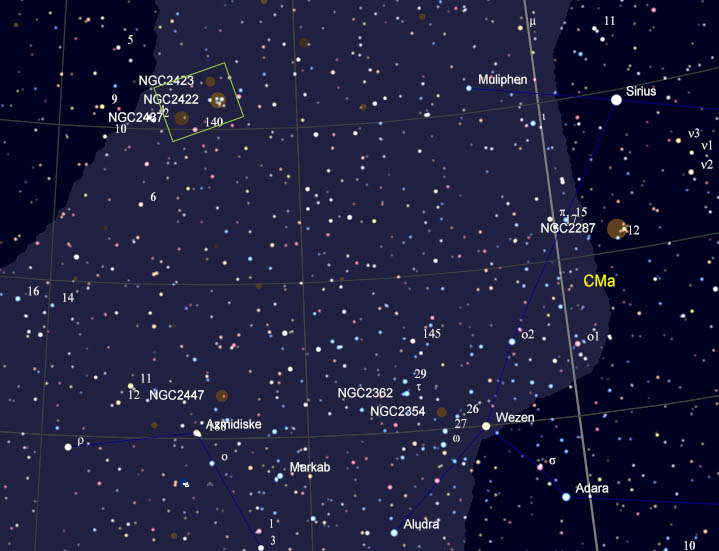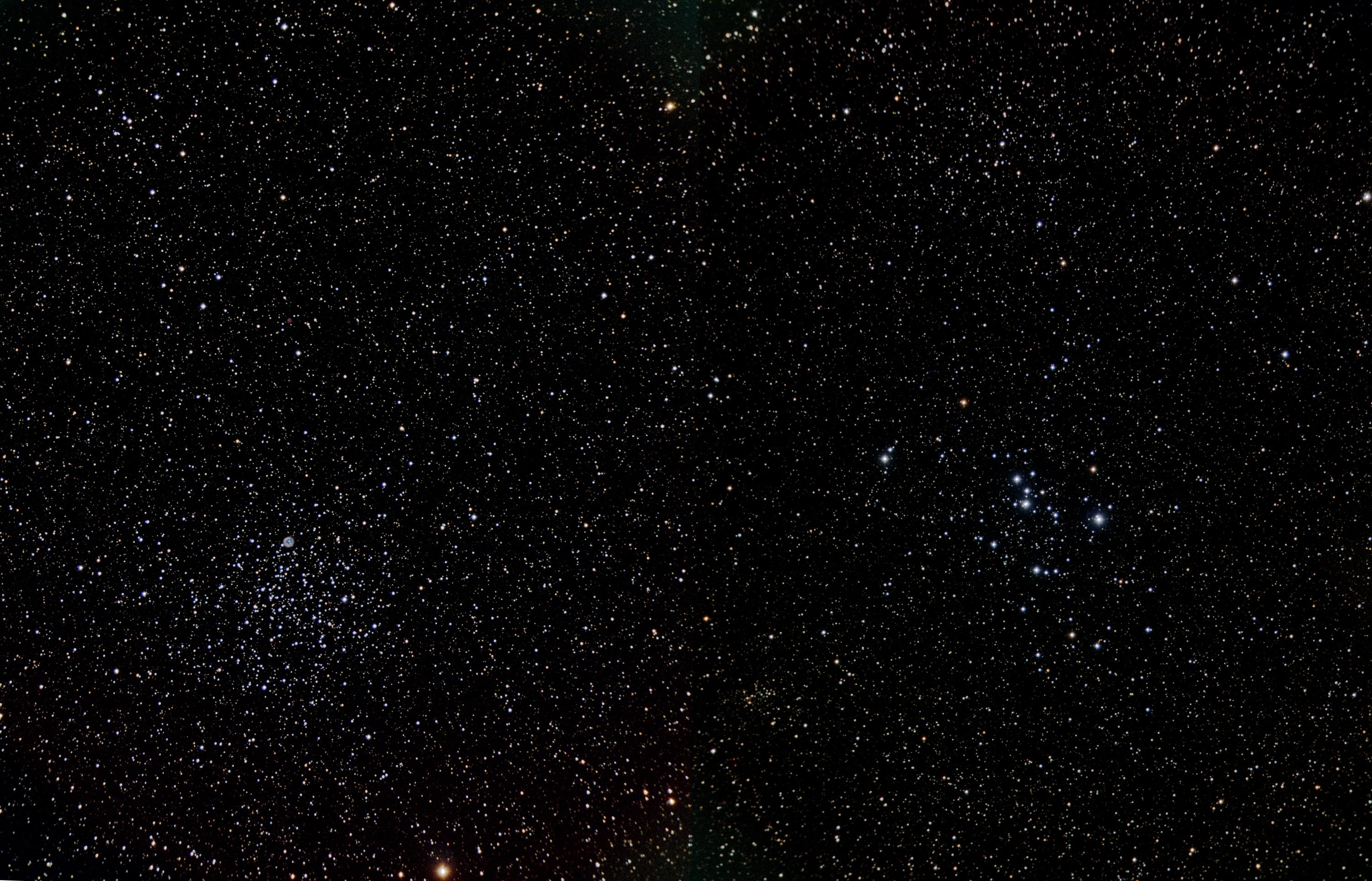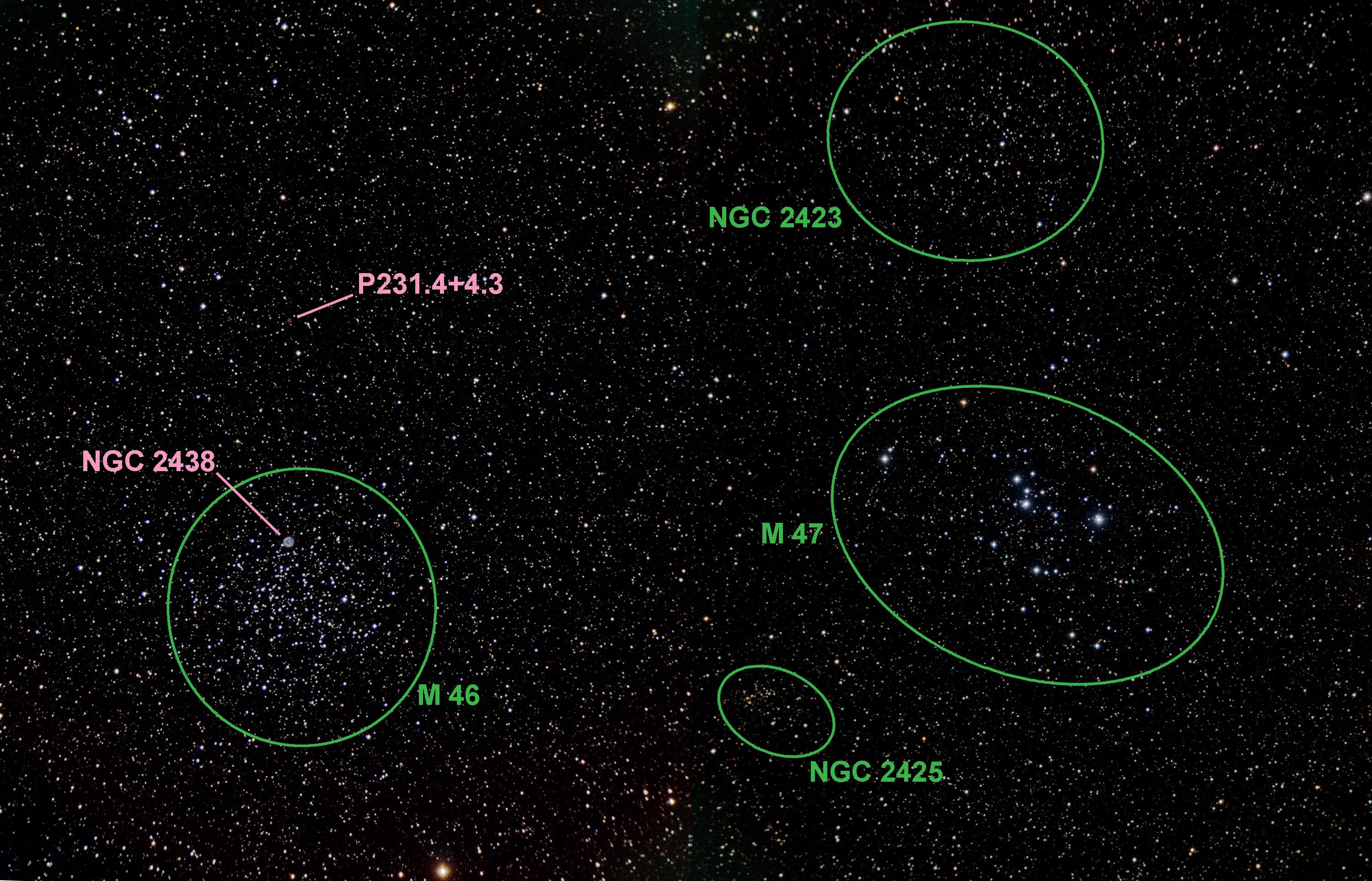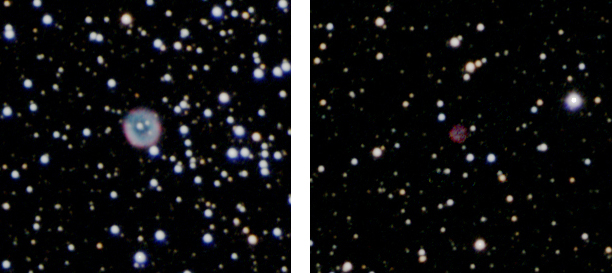
 | SOCO Blog |
20 February 2016
CLUSTERS IN THE BIG DOG
Finally, a string of clear nights with no moon! Here at SOCO, we had great conditions for imaging for nine consecutive nights (4 February through 12 February), along with two earlier nights (29 and 31 January). I was able to image over 20 objects, most of which are now displayed in the SOCO Image Gallery. I still haven't received the revised Astro-Physics mount control software that is supposed to "fix" the bug in it that appeared after New Year's (see my last Blog entry), but I developed my own work-around that has allowed me to continue imaging.
The objects that I imaged were a mixture of late-Winter/early-Spring targets, including star clusters, nebulas, and galaxies. One of the great areas for imaging this time of year is the southern Milky Way. The constellations of Canis Major and Puppis are truly the "land of open clusters", with an almost uncountable number of open clusters both big and small. I ended up imaging more than 10 open clusters in this general region before the moon got too bright, and I've still got more on my list for when the moon begins to wane again. Of all the clusters I imaged, none are finer than the pair M 46 and M 47 in Canis Major. In the Image Gallery, I have presented separate images of each of these clusters. But, in fact, they are separated by only a degree in the sky so I was able to produce a mosaiced image that includes the pair (plus a few other things). Figure 1 shows the general location of these clusters along the stream of the Milky Way. The green box around them in the figure indicates the region included in my mosaic.

Figure 1. Region containing the open clusters M 46 (NGC 2437) and M 47 (NGC 2422).
Source: Adapted from Cartes du Ciel.
The mosaiced image is presented in Figure 2, with M 46 on the left side and M 47 on the right side of the image. In case there's any confusion, I have shown their locations in the version of the mosaic presented in Figure 3. In viewing the two clusters, what is interesting is the marked difference in their appearances. M 46 is a compact scattering of innumerable small stars of comparable magnitude, similar to what we see in the Wild Duck Cluster (M 11) in the constellation Scutum. In contrast, M 47 is more open and scattered, and is dominated by a handful of bright blue-white stars reminiscent of the Pleiades (M 45). This visual difference is in part due to the richness of each cluster. M 46 contains on the order of 500 member stars, 186 that are brighter than magnitude 13. M 47, on the other hand, contains around 117 member stars spread over an area of around 30 arc-min in diameter— but what dominates the view is around a dozen bright blue giant stars, the brighest of which is magnitude 5.7. The other factor that contributes to the difference in their appearance is their distances. M 47 is relatively close to us, at an estimated distance of 1600 LY. M 46 is almost three times as distant, with an estimated distance of 4480 LY.
Besides the blue giant stars, M 47 contains two red giants that can be seen floating along the upper border of the cluster in my image. It is not certain whether these two red giants actually belong to the cluster. This has led to uncertainty in estimating the age of M 47. If they are physically part of the cluster, then the cluster age should be around 100 million years. If they are not really part of the cluster, then the cluster is much younger— around 30 million years. M 46 is much older, with an estimated age of around 500 million years.

Figure 2. Mosaic containing M 46 on the left and M 47 on the right of the image.

Figure 3. Locations of M 46 and M 47 in the mosaiced image, along with other objects.
Besides M 46 and M 47, there are two other open clusters hiding in Figure 2. NGC 2423 is a large, loose cluster that is somewhat difficult to pick out from the background of Milky Way stars. It contains around 86 member stars spread out over an area about the same size as M 47. It lies at a distance of around 2460 LY, intermediate between M 47 and M 46. More obscure is NGC 2425, a small straggling group of around 30 member stars all but lost in the background Milky Way.
As you have probably noticed, there is something else in M 46 besides stars. The small "soap bubble" floating amidst the stars of the open cluster is the planetary nebula NGC 2438. It was discovered by William Herschel in 1786 and is fairly bright, with a visual magnitude of 10.8. An enlarged view of it is shown in Figure 4. It exhibits the typical outer edge of red Hα emissions and intereior greenish-blue glow of OIII emissions, making it a miniature Helix Nebula. There is still debate as to whether this planetary nebula is physically a part of the cluster or just a foreground object. At only 45,000 years, NGC 2438 is much younger than the rest of M 46. It is notoriously difficult to determine the distances to planetary nebulas, so there is no direct evidence that NGC 2438 is physically part of M 46. However, studies indicate that NGC 2438 and M 46 do have similar proper motions, which supports the hypothesis that the nebula is part of the cluster. If this is the case, NGC 2438 would have a physical diameter of around 1 LY.
Interestingly, studies show that the radiation from the central star in NGC 2438 (which produced the expanding shell of gas that constitutes the planetary nebula) has fallen to levels that are no longer capable of ionizing the gas of the nebula. The light from the nebula that we see today is coming from the re-combination of electrons with atoms previously ionized by the star. This process is anticipated to be finished in a few thousand years from now so, after that time, NGC 2438 will become invisible to observations in the visible wavelengths of light. So, enjoy it while you can!

Figure 4. Planetary nebulas, NGC 2438 (left) and P231.4+4.3 (right).
There is another planetary nebula in my image. As indicated in Figure 3, the tiny red circular feature above M 46 is the planetary nebula P231.4+4.3. An enlarged view of it is shown in Figure 4, although there is still little detail to be seen. About all you can tell is that it has the glowing red shell of Hα emissions and possibly an interior of greenish-blue OIII emissions. A brief search on the Internet did not reveal any additional information about this object. This is definitely a target for much larger telescopes.
The discovery of M 47 is credited to the Sicilian astronomer Giovanni Batista Hodierna, who included it in his list of deep-sky objects that he published in 1654. In that list, he described it as "a nebulosa [an object he could not resolve into stars] between the two dogs [Canis Major and Canis Minor]." Hodierna's publication was not in wide circulation, and was lost until it was re-discovered in 1984. So, M 47 was independently discovered by Charles Messier on the night of 19 February 1771. He discovered M 46 on the same night. Unfortunately, when Messier recorded the position for M 47, he made a sign-related error. Thus, later observers could not find the cluster that Messier had described. In 1959, T. F. Morris went through Messier's calculations and recognized the error, so that the identity of M 47 could once again be confirmed.
So many interesting objects in such a small space! That is one of the great things about astronomy— you can't possibly run out of things to see.
 Return to SOCO Blog Page
Return to SOCO Blog Page
 Return to SOCO Main Page
Return to SOCO Main Page
Questions or comments? Email SOCO@cat-star.org